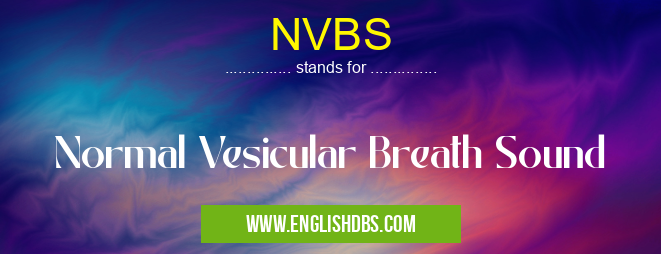What does NVBS mean in MEDICAL
Vesicular breath sounds are a type of respiratory sound heard through a stethoscope. They are usually associated with healthy lungs and indicate normal breathing function. Vesicular sounds are created by air passing through the small airways in the lungs. These sounds come in two varieties, “normal†and “abnormal†- Normal Vesicular Breath Sounds (NVBS).

NVBS meaning in Medical in Medical
NVBS mostly used in an acronym Medical in Category Medical that means Normal Vesicular Breath Sound
Shorthand: NVBS,
Full Form: Normal Vesicular Breath Sound
For more information of "Normal Vesicular Breath Sound", see the section below.
Explanation
Normal Vesicular Breath Sounds (NVBS) are breath sounds typically heard during auscultation using a stethoscope. During inhalation, they are described as low-pitched, soft, and muffled; while on exhalation, they can be slightly louder than during inhalation but still maintain their low-pitched sound. NVBS occur when there is no abnormal pathology to obstruct airflow within the lungs' smaller passages. When heard through a stethoscope, NVBS from either side should be of equal intensity and pitch. NVBS may also be heard in locations where airway narrowing or obstruction is present; however, more often than not these locations will produce additional sounds such as diminished inspiratory breath sounds or wheezes/expiratory crackles.
Essential Questions and Answers on Normal Vesicular Breath Sound in "MEDICAL»MEDICAL"
What are normal vesicular breath sounds?
Normal vesicular breath sounds are low-pitched, continuous sounds that occur naturally during inhalation and exhalation when a person is breathing normally. They can be heard with a stethoscope placed on the chest wall or back.
What is the difference between abnormal and normal vesicular breath sounds?
Normal vesicular breath sounds have a low-pitched, continuous sound that is heard when someone is breathing normally. Abnormal vesicular breath sounds may have an increased pitch and/or a discontinuous sound where there are breaks in the pattern of airflow heard. These changes can indicate various conditions such as asthma, chronic obstructive pulmonary disease (COPD), or pneumonia.
How do healthcare professionals listen for normal vesicular breath sounds?
Healthcare professionals typically use a stethoscope to listen for normal vesicular breath sounds. The stethoscope should be placed directly on the chest or back so the healthcare professional can hear the airflow of inhalation and exhalation clearly.
Can I detect normal vesicular breath sounds without using a stethoscope?
It is difficult to detect normal vesicular breath sounds without using a stethoscope because they are quiet and low-pitched. The best way to accurately assess if someone's breathing is normal is to use a stethoscope with an experienced healthcare professional to monitor their inhalation and exhalation patterns.
Are there any indicators that indicate abnormal vesicular breath sounds?
Yes, there are some indicators that may point towards abnormal vesicular breath sounded such as an increase in pitch, discontinuity in airflow causing breaks in the pattern, wheezing or crackling noises associated with shortness of breath or coughing. These could be indicative of various conditions like asthma, COPD or pneumonia that would require further evaluation by a physician for proper diagnosis and treatment.
Does age influence how recognizable normal Vesicular Breath Sounds are?
Age does not significantly affect how recognizable normal Vescular Breath Sounds are; however it may affect their pitch due to changes associated with aging such as weakened lung capacity, obesity or other medical issues which can lead to difficulty hearing these tones clearly even with a stethoscope.
Is it necessary to seek medical attention if I think I've noticed abnormal Vesricular Breath Sounds?
Yes, it can be beneficial to seek medical attention if you think you've noticed any type of abnormality that could indicate something more serious than just being out of shape and lacking exercise; this could include worsening symptoms like coughing, wheezing, shortness of breathe etc.. In many circumstances early detection is key so seeking medical care could help diagnose any underlying illnesses and begin treatment quickly before things worsen.
How does my doctor determine whether my Vesicular Breath Sounds are normal?
Your doctor will use a stethoscope listening for signs of changes in pitch or rhythm from one exhalation to another which would suggest any underlying issues. Depending upon your symptoms your doctor may order additional tests like chest x-rays CT scans or pulmonary function tests as well as blood work depending upon what he/she suspects might be causing your breathing difficulties.
How will my doctor treat abnormalities in my Vesricular Breath Sounds?
Depending on what underlying condition has been identified by your doctor he/she will create an individualized treatment plan aimed at managing specific symptoms while also easing discomfort while treating whatever illness has been diagnosed.
Are there risks associated with ignoring abnormal Vesricular Breath Sounds?
Yes, ignoring abnormal Vesricular Breath Sounds can lead up more serious problems caused by any underlying illnesses not being treated promptly including respiratory failure needing mechanical ventilation support or worse.
Is there anything else I should look out for regarding my respiratory health aside from paying attention to my Vesricular Breath Sounds?
Aside from paying attention to your Vesricular Breath Sound signs like sharp pains during inhalations/exhailations, frequent coughing, shortness of breathe etc., should also alert you that something else might be going on with your lung health thus visiting your primary care physician who specializes in pulmonary illnesses could help diagnose any other potential respiratory infections you might have.
Final Words:
Normal Vesicular Breath Sounds (NVBS) indicate that the patient is experiencing normal lung function and anatomy with no obstructions or irregularities to impede airflow within smaller pathways within the lungs of the patient being examined. Together with other physical signs such as respiratory rate and pulse oximetry readings, NVBS help clinicians determine the overall health status of their patients' respiratory system.
